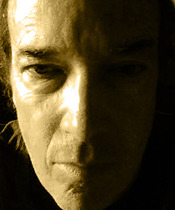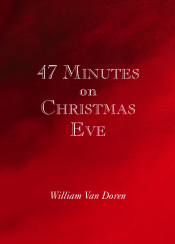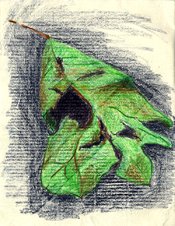Sunset, Friday, 20 November 2009
 William Theodore Van Doren. Stony Point, Albemarle County, Va. Oil on paper, 16 x 20.
William Theodore Van Doren. Stony Point, Albemarle County, Va. Oil on paper, 16 x 20.
I’m happy the sun came back out for my brother Steve’s 60th birthday.
Rain, earth, sun. That’s more or less the theme from a long walk today, although those three elemental words immediately distracted me by making me think of writing about D.H. Lawrence. Another time. D.H. did loop back around to my brother, whose middle name is Lawrence, but I guarantee Steve wasn’t named for any author.
My college roommate recently wrote, “I was raised to consider myself part of an intellectual elite.” That just goes to show what an interesting culture gap we had to deal with in our early days at Hopkins. Steve and I et al. were raised to consider ourselves ... I have no idea!
Steve’s name was inspired by Steve Van Buren (Stephen W.), a pro football hero whose greatest fame came with the NFL championship games of 1948 and 1949. I don’t think Steve has ever given much consideration to the curious fact that he was named after a running back for the Philadelphia Eagles, of all things – not exactly a well-loved franchise in our experience.
Anyway, even though the Van Doren family, at least, had, in previous generations, a pretty strong tradition of preserving and passing names around, I suspect my parents were part of a (possible?) postwar trend toward naming your kid any damn thing you wanted. I’m the only one who got someone’s name – my grandfather’s – which was his grandfather’s, so break out the roman numerals. I think the story we always heard was that ‘Stephen Lawrence Van Doren’ sounded good.
Sounds very good to me.
Rain, earth, sun. But look, before I get there, I have to ask. My wonderful, many-marvel’d spouse, who is hardly ever wrong – as a consequence of which I now owe her exactly $8700 from all the bets I’ve lost with her – thinks that posts like this one – you know, the ones where it sounds like maybe I got only three hours of sleep and then walked seven miles, so that I go off on the slightest tangent through a lack of inhibitory frontal cortex function – anyway, that people might not like such long posts. What do you think? If you disagree with Laura I will be especially interested in hearing from you. There’s no money involved, unfortunately.
At the first stream we (Flint the foxhound and I) crossed today, I was struck by the effects of yesterday’s storms. The stream banks, where they’re normally a smooth, almost shiny sandy clay, had been beaten down into a flat, matte, finely stippled surface much like the beach after a long steady rain. The water of such a small stream, only yards from the source, is usually quick to rise and just as quick to fall, leaving a clear low current just as before – but today, 12 hours after the rain had ended, the water was still somewhat up and, I was surprised to see, slightly turgid. Dead leaves were pasted to the ground, the trunks of beeches, hollies and poplars looked scrubbed and a clearing sky seemed reflected in the field.
The rain, in short, had washed the face of the earth. (And even though hundreds if not thousands must have written this before, it feels so accurate to my impression I don’t care.)
Thanks to the wash, we could see along the jeep trail that no hunters had come in today. This meant a lot less uncertainty about what was out there in the 1000+ acres, and less likelihood of “Cold Mountain moments.” That’s what I call creepy, spooky feelings like those the reader gets when Inman is up in the isolated deep mountains and you don’t know if the Home Guard is about to find him. In my case, they can come from not knowing where hunters are or not knowing what Flint may be barking at or chasing, off in the distance.
As for Charles Frazier’s intensely wrought creation – I don’t mean to quibble – it’s not every book that earns a place in one’s vocabulary – but I wouldn’t have minded holding it open to the rain and washing out just a little of the melodrama. In a sense I wanted fewer Cold Mountain moments in Cold Mountain. But that’s me. I’m also crazy enough to wonder, quite seriously, if entire novels might be constructed from rain, earth, sun.
 Friday, November 20, 2009 at 06:14PM | by
Friday, November 20, 2009 at 06:14PM | by  BVD | in
BVD | in  Sunset Paintings | tagged
Sunset Paintings | tagged  Blue Ridge,
Blue Ridge,  Charles Frazier,
Charles Frazier,  Cold Mountain,
Cold Mountain,  D.H. Lawrence,
D.H. Lawrence,  Flint the foxhound,
Flint the foxhound,  Johns Hopkins University,
Johns Hopkins University,  Laura Owen Sutherland,
Laura Owen Sutherland,  Laurence Shatkin,
Laurence Shatkin,  Philadelphia Eagles,
Philadelphia Eagles,  Stephen Van Doren,
Stephen Van Doren,  Steve Van Buren | | Comments Off
Steve Van Buren | | Comments Off 











Images of the Sunset
This all started – well, in a way the change really started the moment I began painting sunsets and sunrises over 14 years ago. From the beginning, there’s always been tension between two tendencies.
On one side there’s what you might call just keeping the appointment with the sunset – just doing it – being there and painting. Entailed in this are the many implications, meditative and metaphysical, of ‘following the sun’.
On the other side, there’s the goal of painting a certain kind of image – an aesthetic goal. In other words, making a damn good painting.
To paint the sunset every day – and for two years both sunrise and sunset – especially while earning a living doing something else – means the painting you make is the painting you get. There’s no time for do-overs or revisions or long processes of development or elaboration of any one image. Everything is alla prima – done in one go. They are whatever they are.
Of course, it’s not only a matter of time – there’s also the kind of sky that happens on a given day.
From the beginning, I was – I think necessarily and even productively – divided. Do you want it fast or do you want it good? It had to be fast or the whole project would break down. It had to be good or there would be little joy in continuing. These two aspects were always in play – in a sort of balance.
Adding this blog – starting in April – intensified the tension.
First, the added steps involved in posting, plus writing, meant more pressure on the available time. Now I needed not only to paint but to cut the painting out of its watercolor block (for example), tape it to a wall for shooting, clean brushes, wash hands to avoid clogging the Nikon with cadmium yellow, adjust lights, shoot, offload, save file, upload, write, and preferably do all of this before everyone in this part of the world had gone to bed – and in time for some dinner! (We have dinner late, so in summer these things collide.)
But second, communicating with you – you know who you are! – also has meant I’m more aware of the qualities of each image.
Until now, I resolved this tension by understanding that the value of the series resided both in the fact that I went out every day and painted the sky and in the way I painted it. If they weren’t of a certain quality, doing them every day wouldn’t mean much. Yet doing them every day imbued them with a sort of message about the passage of the days – a relationship with time.
So, I resolved the tension by not resolving it, because it can’t be completely resolved. I accepted both sides. But the balance can shift. And now I think it has.
At this point, from stage left, enters my brother Steve (a metallurgist by profession, developing materials for aerospace). Then, from stage right, in honor of Bastille Day, a Frenchman, Marcel Proust. More precisely, I’ll bring in one of his translators, Lydia Davis. They helped me see where this was going.
So, at our lunch in Frederick the other day, Steve said something to me that was very similar to the sort of thing people will say from time to time. He really liked the painting of a particular sunset (June 15th) – and then he added something like, “Not that I don’t like them all, but that one seems special.”
I knew what he meant because I often feel the same way. Every so often this everyday process yields something that is more remarkable, in and of itself, as an image.
I think I was ready to hear his comment: I felt I wanted to do more of those kinds of images.
Now, I should preface the following by stipulating that no one who has just finished reading their very first volume of Proust (Swann’s Way, from In Search of Lost Time) should be allowed (1) to comment on it in public, and especially and above all (2) to draw any sort of connection between it and their own work. It isn’t done, and should never be done.
In my defense, I will say that I read it very ... very ... slowly ... over a period of at least six months, almost exclusively on Sunday mornings. And you thought I didn’t go to church.
(I know a couple of people who could read it in one Sunday, but Gillian, Sarah, sorry, hate you both.)
Anyway, I’m not actually going to get into Proust, just the introduction by Lydia Davis, which I read after I finished the book, and which, like Steve’s remark, probably struck me because I was ready for it:
I thought about how I’d often said that the sunset paintings completely submit to time but also suggest something beyond time. I realized (for the first time!?) that one way the sunsets deal with time is by holding back a piece of it.
I had written the following a few days ago, before I read Lydia Davis. I ended up not posting it because it didn’t feel right at that time. But now maybe it does:
What I realize, thanks to Stephen L. Van Doren and M. Proust (together again for the first time) (don’t worry, Steve won’t mind that a bit), is that just bravely going forth and painting the sunset every day and occasionally getting a really strong image isn’t enough for me.
To find the timelessness inside time, I need to go for whatever art can get.
I know not every image will work, but ... we’ll see what happens.